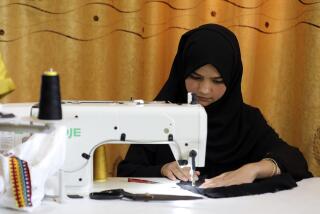AFGHANISTAN PROGRAM: COLOR SANS CLARITY
- Share via
Camels. Swift horses. Charging tribesmen. The crack of rifle fire. There are times when “The Battle for Afghanistan” resembles an old-fashioned costume epic.
The heroes of this “CBS Reports,” airing at 10 tonight on Channels 2 and 8, are not Hollywood actors or stunt men, though. The heroes are real-life Moujahedeen--resistance fighters in Soviet-occupied Afghanistan--and their video Boswell, free-lance cameraman Mike Hoover.
Hoover has trekked 18 times to Afghanistan, a mountainous land framed by the Soviet Union, Iran and Pakistan. He and his crews, at various times including Ron Peers, Michael Graber, Beverly Johnson and Musa Rafferty, have provided the remarkable combat footage that makes this hourlong program worth watching. The results of their perilous work--much having already aired on the “CBS Evening News”--do indeed narrow the gap separating Afghanistan and Peoria. Because of their risks, we can sit safely in our homes watching others die in a distant war.
A distant, confusing war.
On a visceral level, the pictures don’t require elaboration. The good guys and bad guys are distinct and separate, and the right emotional buttons are there for the pushing. We all relate to hardship, conflict, danger and an underdog opposing a mighty oppressor. So far, so good.
What “The Battle for Afghanistan” also shows, unfortunately, is that pictures--even ones as compelling and dramatic as these--cannot alone tell a complex story. Consequently, this program is less a clear examination than an unfocused hour resting on a series of random living snapshots that bring credit only to the picture maker and his subject, not the documentary maker.
Like so much of TV, the message is the picture, an approach that works for fires and freeway crashes, but not for embattled Afghanistan.
“The Battle for Afghanistan” does humanize the headlines and reduce the obscurity level. On the screen are rebels fighting the Soviets and their Afghan conscripts. The fight is hazardous. Hundreds of thousands of Afghans have died in the war; millions more--perhaps a third of the population--have fled to Pakistan and Iran.
As written by executive producer Perry Wolff, however, the choppy narration is inconsistent and bafflingly vague, even taking into account certain conditions placed on Hoover by the guerrillas. You have the impression that someone at CBS News said: “We have these terrific pictures. Let’s turn them into a special whose footage will so overwhelm viewers that the words won’t matter.”
Dan Rather is the narrator, but it’s clearly not his stage. “The Battle for Afghanistan’s” primary goal is to celebrate the skill and bravery of the person behind the camera. And on that level, it succeeds mightily almost from the opening blast.
The impression is immediate. Guerrillas negotiate a minefield. Then a guerrilla defuses one of the mines with the camera almost in his face. That means if the mine blows, so does the camera operator.
In another sequence, Hoover and his crew accompany a band of guerrillas hoping to knock out a Soviet hydroelectric dam whose destruction would cause a blackout in the capital of Kabul, thereby signifying hope to the resistance. The guerrillas are surprised by a Soviet convoy and caught in a crossfire.
A full-blown military action is shot at night with a special lens. Artillery fire streaks the night sky like an electrical storm.
In one of the program’s most spectacular sequences, the camera follows a guerrilla carrying a grenade launcher into an open field--vulnerable and exposed--from where a Soviet tank is fired upon. The shot misses and the fire is returned.
Then, from a ditch at the side of a road, you get a guerrilla’s-eye-view of a Soviet armored personnel carrier rumbling by in the night as the guerrillas hide. As if one of them, the camera huddles with the Moujahedeen. You can’t get closer to war than this.
Soon, out of the night, Soviet-conscripted Afghan soldiers make an eerie, ghostly appearance, giving themselves up to the guerrillas, their arms lifted in surrender.
Afghan children also appear in Hoover’s pictorial. Some are soldiers (there is a brief shot of a guerrilla who can’t be more than 10 or 11), others victims of booby-trapped toys.
We tend to take even the most startlingly powerful pictures for granted when they’re homogenized in a newscast that tends to render all stories and pictures equal. So now is as good a time as any to stand back and applaud.
What’s missing, though, is something giving Hoover’s pictures meaningful perspective, something that sharpens the focus instead of blurring it.
The Soviets invaded Afghanistan in 1979. Yet there are no dates, no years attached to these pictures, almost as if they were in a time warp. Only by reading a CBS press release do you learn that the footage summarizes battles from the last three years.
We get a balcony seat for an attempted capture of a Soviet-controlled town labeled “the biggest operation of the entire war,” a three-day battle that the guerrillas lose. No date.
When the Soviets counterattacked two months later, “it was the low point of the war,” Rather says. Two months from when? The United States “escalated the war” several months later, he adds. Several months after the two months after the big operation whose date is not given?
“What (the guerrillas) most wanted and did not have when these pictures were taken was thousands of surface-to-air missiles. . .,” Rather says at another point. Yes, but when were these pictures taken?
The United States, Rather says, didn’t give the guerrillas Stinger missiles “at this time.” What time is that?
Is this a quiz show? Can some lucky viewer win two weeks in Kabul by supplying the correct time sequence?
When details are given, some of them are confusing. At one point, Rather notes that U.S. aid to the guerrillas is “clandestine.” But later he says that Congress “gave about a half-billion dollars in aid to the Moujahedeen.” Does he mean that Congress overtly approved covert aid?
TV is the medium of the immediate, one that thinks of history as 10 minutes ago. Hence, no historical context is given for Afghanistan’s present conflict with the Soviet Union, no reference points to plot the progression of centuries leading to this clash of modernism with Islamic feudalism and fundamentalism.
With apparently no pictures to support that story, it becomes a non-story.
CBS News says that it has aired 245 Afghan-related stories since 1979. That may sound like a lot, but it amounts to only one story about every two weeks (and a disproportionate bulk of those probably came early in the occupation, when a protesting United States withdrew from the 1980 Summer Olympics in Moscow). That’s modest for a conflict whose stakes are said to be so high.
Meanwhile, the guerrillas continue hitting and running, only briefly controlling chunks of countryside, unable to stay in one place for long, transients in their own land.
More to Read
The complete guide to home viewing
Get Screen Gab for everything about the TV shows and streaming movies everyone’s talking about.
You may occasionally receive promotional content from the Los Angeles Times.






